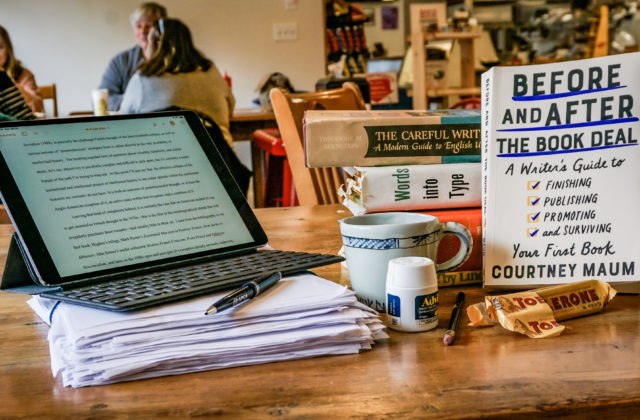Local Author Writes a Guide to Publishing for Aspiring Writers
NN Book Review
Text by Michael Selleck
Photo by Clinton J. Sosna
I spent my entire career in the book business, first as a bookseller for eight years followed by 35 years in publishing, and even today I coproduce a podcast, with bookseller Roxanne Coady, called “Just the Right Book.” Inevitably, I am asked on a regular basis if I can help someone get their book published. The queries came from everywhere, my mother’s best friend’s son, my cousin’s first wife, the nephew of a schoolmate from when I was in the sixth grade, waiters, plumbers, friends of friends—everyone, it seems, has written a book. It’s hard to know what to tell them.
Finally, Courtney Maum has written the answer to my prayers: Before and After the Book Deal: A Writer’s Guide to Finishing, Publishing, Promoting, and Surviving Your First Book.
Courtney is the author of three novels, and I had the pleasure of working on her first book, I Am Having So Much Fun Here Without You, at Simon & Schuster. The new book is her first venture into the world of nonfiction, and everything between the covers is a firsthand account of a writer’s experience in getting their book finished and onto the shelves of a bookstore—and into the hands of readers.
The book is broken down into two main sections, “Before the Book Deal” and “After the Book Deal.”
Although people tend to think that writing a book is easy, in fact the writing process is complicated and layered, as Maum so excellently explains in her book. The first chapter, “Getting It Right,” is chock-full of hands-on advice on the potential difficulties, from overcoming your doubts to finding the time, space and energy to work. She writes honestly about her own experience and brings you right down to where you need to be—in the weeds.
Once you’ve got a manuscript, or part of one, that you’re happy with, the next step is to get others to read it. Its not as easy as just putting it in an envelope and mailing it off to a publisher. If you do that, you’ll get it back! Maum gives you the tools you’ll need for getting the feedback that will move your project to the next step. And the next step is sometimes to withdraw and rewrite. She provides lots of support from an emotional perspective. Rejection is difficult but feedback is important, and it can make your project better.
Next you need to go shopping for an agent to represent you. Finding the right agent is just as important as finding the right publisher. Your agent will become not only the person who represents you to the publishing world but also a friend, ally and confidant. I read a recent interview with Maum where the interviewer said that your agent should be the president of your fan club, to which Maum replied, “They should like you, obviously, but they should make you work.” She compared her agent to a personal trainer.
The publishing world is very connected. Certain agents represent certain types of writers—they specialize in specific genres. For example, many agents represent fiction writers, but some may only handle novelists with a romantic twist or a humorous twist. The editorial departments at publishing houses are similar; editors like certain types of books that usually follow their personal taste and interests.
That’s why finding the right agent is so important. Agents usually know as soon as they read something which publishing houses and editors they think will be interested in that project. They are probably already thinking about a financial range for the acquisition as well. Maum lays all this out and provides an excellent map for the entire process from pitching your story to negotiating it.
The publication of a book is a moment for celebration, but after all the hard work and grand expectations, the actual event can be somewhat disappointing. Most editors will talk to their authors at some point about the reality of publishing. Most books never become bestsellers. In fact, most have very small sales and get little fanfare. Maum writes about success and what constitutes a successful launch. She writes about debut breakout books but notes how uncommon they really are.
If you follow Courtney Maum on social media like I do, you know that she is an avid promoter of her books and fellow authors. She is currently on the first leg of her tour for Before and After the Book Deal and will be heading out on her second leg very soon. As she spells out in her book, the book tour can be a powerful tool to connect with readers, and it provides a platform for the author to promote on social media. Promotion tours are done in conjunction with the publisher and booksellers, so that all are cross-promoting the events.
Throughout her book, Maum includes anecdotes and experiences from other authors, and at the back of the book a range of contributors share their best advice for debut authors. Authors, editors, publicists, poets and agents—it’s a great collection of advice from some of the brightest minds in the industry. Maum concludes with an excellent section on resources and references.
I would strongly recommend this book any writer who is looking to get their work published, and to published authors as well. If I were still actively managing a publishing staff in publishing, I would recommend that they all read this book. Not only is Before and After the Book Deal the perfect master class for writers, but it would provide excellent insight into authors and the challenges they face for the publishing staff as well.

